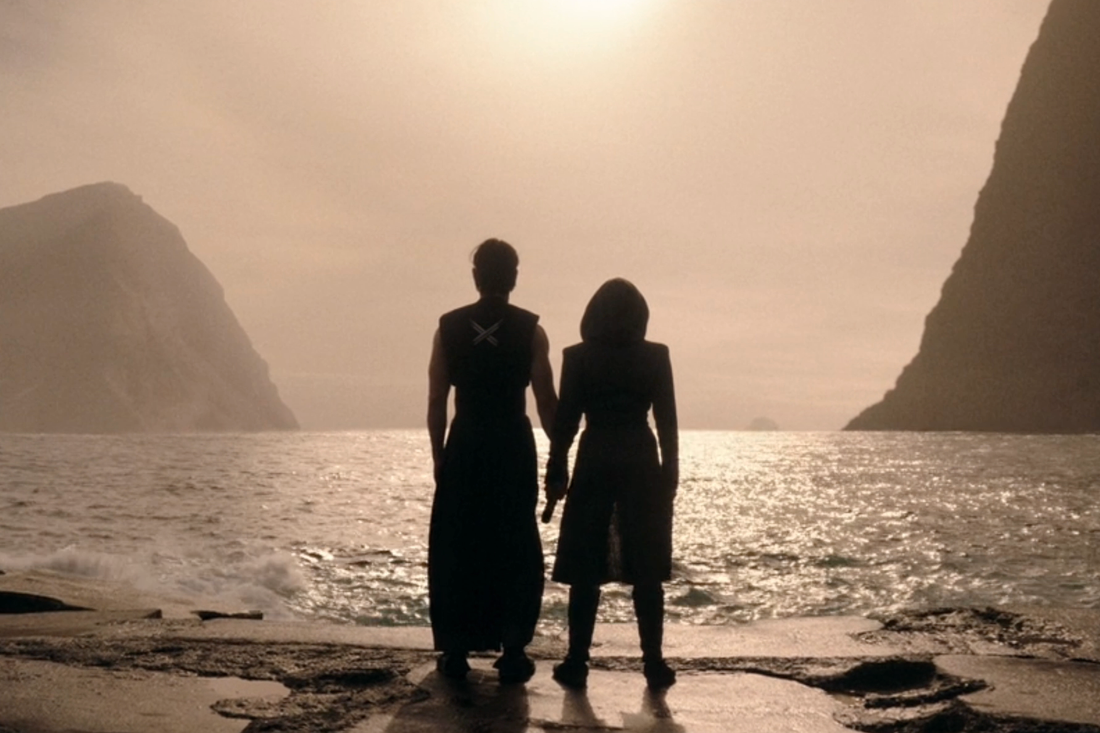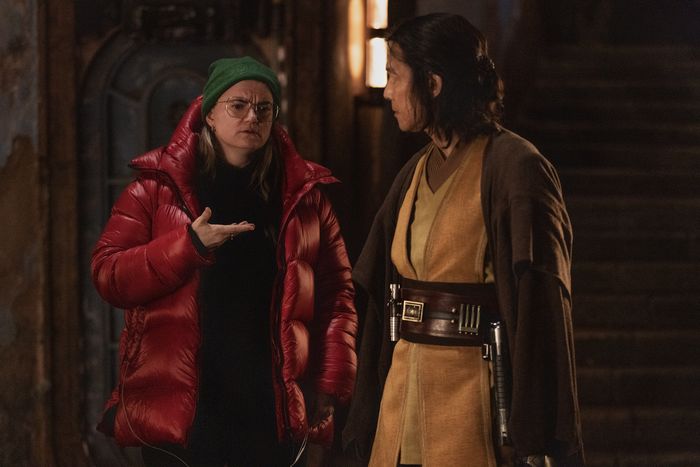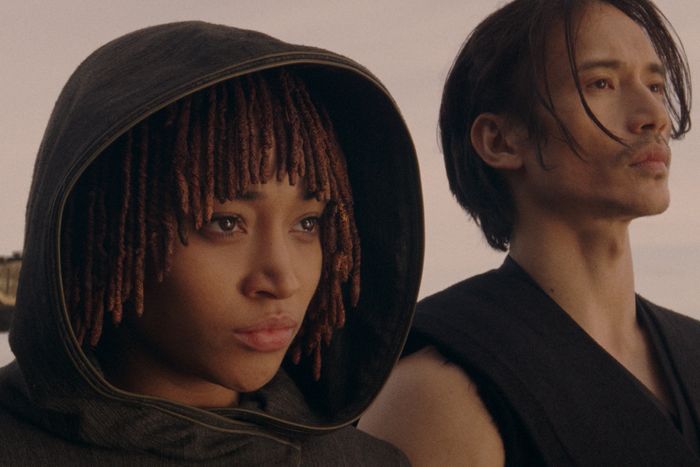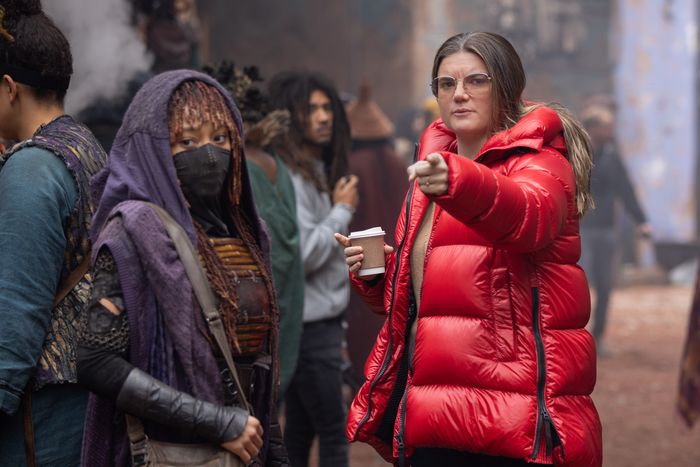
Spoilers ahead for the season-one finale of The Acolyte.
“So many times I’ve watched mainstream media and just thought, Why can’t this female character be evil?” says Leslye Headland, writer-director-creator of Disney+ Star Wars series The Acolyte. Sometimes, that character gets tempted but then nobly goes right back to being good. In The Acolyte, however, she does not resist. Over the course of eight episodes, Amandla Stenberg’s Osha goes from failed Jedi trainee who couldn’t control her emotions to giving into those emotions and embracing the dark side. Along the way, she’s encouraged by her twin sister, Mae (also Stenberg), who is on a quest for revenge against the Jedi, and the mysterious Stranger (Manny Jacinto, introduced in the guise of cover name “Qimir”), who trained Mae before turning his sights on Osha. In the climax of the season finale, Osha channels all her repressed rage against her former master Sol (Lee Jung-Jae), killing him to avenge the murder of her mother, and bleeds the Kyber crystals of his lightsaber, turning it from blue to red.
This moment, like much of the show, plays like a minor-key remix of many classic Star Wars themes and anxieties: the father-son reconciliation between Luke and Anakin in Return of the Jedi transposed into a father-daughter dynamic in which reconciliation does not come to pass. As in the prequels, the Jedi don’t come out of The Acolyte looking especially noble, while the Sith seem more reasonable than ever, or at least more seductive. The show has perhaps inevitably provoked furor from some Star Wars fans, whether mad about how Headland interpreted the lore or about her injecting the franchise with her politics. (“George made it political!” says Headland. “It’s called Star Wars — wars are political!”)
Franchise work itself may seem like a left turn for Headland as a writer, but all The Acolyte’s themes are right in her wheelhouse. She started her career as a playwright, writing a series of seven works centering on the seven deadly sins. Her take on gluttony, Bachelorette, became a film; the last of plays, Cult of Love, about the sin of pride and inspired in part by Headland’s experience in a devoutly Christian family, will premiere on Broadway this fall. But after her Netflix series Russian Doll hit big, Headland, who was a childhood Star Wars fan, took a pitch to Lucasfilm to write a story about the bad guys. There’s a connection, as it turns out, between her fascination with sin onstage and her fascination with characters who struggle to command their own emotions in Star Wars. There’s also the ways people are shaped by institutions and the potentially unhealthy patterns they fall into trying to conform or rebel against them. “Nobody thinks they’re the bad guy, and going into that with sympathy and compassion for the characters, that’s what I’m all about,” Headland says. “I was able to work in this world that I love so much and bring me to it, as opposed to trying to acquiesce or mold myself to some other thing. I couldn’t be prouder.”
In the finale, Osha kills Sol right as he’s trying to say that he loves her. How did you think about constructing that moment?
It was always the plan to have Osha kill Sol because Luke forgives his father. Luke throws away his lightsaber and embraces the destruction of that generational lineage with forgiveness and compassion. He’s a good and noble character, the epitome of a Star Wars hero, and this is a show about Star Wars villains. She needed to destroy that generational lineage.
We knew that you would slowly understand, over the course of eight episodes, that Osha had put so much faith into Sol and was hoping to receive the love she had received as a child. I know the Jedi wouldn’t use the word love, but that’s what she was seeking. She needed to say, “It does not matter if you say ‘I love you’ because I have been living in the shadow of this my whole life.”
Star Wars is so much about family dynamics, especially with the Skywalkers, but that’s usually all father-son stuff.
The image of Luke slaying Vader in the Dagobah cave and then seeing his own face in the helmet really stuck with me from childhood. It was a talisman I would always touch, like, This is what it’s about. What if I’m the bad guy? Do I feel like the bad guy, but I’m not? Am I being villainized by the people I love most? Or is this thing already in me and the otherness, the thing I’m afraid of, what I should embrace about myself?
I started out wanting to explore the sister relationship, then my father got very sick in the middle of developing this and it turned into this father-daughter relationship. My dad died in September. As we moved forward with the story, I got sucked into my own feelings about his illness and our history together. Kathleen said, “George wrote about his father. You need to write about your sister. You need to write about your father.” Luke felt betrayed by his father in the way that George didn’t want to take over his father’s hardware store. My father made so many promises to me, and I felt like I failed because I couldn’t live up to those expectations. Of course I’m going to lean toward the other side, the dark side, the otherness. That system has its own societal expectations, but I’m more comfortable there than when I was trying to live up to what you wanted for me.
When you have the type of father Sol is, there’s an inability to recognize that paternalism as insular. Osha has to destroy her father to keep moving. I don’t know what it means, but for father-son relationships in Star Wars, there’s reconciliation. For father-daughter, there isn’t.
Sol’s the one who gives young Osha the chance to hold a lightsaber, and then when she leaves the Jedi she has it taken away. It’s compelling, then, that the Stranger is the one who offers her the chance to hold one again. Here’s a woman coming of age through this power her father gave and then denied her, entwined with her discovering her sexuality.
There is danger in Manny’s character, too. You should question his philosophy because it is just another philosophy. But he’s telling her his truth and she can ascribe to it or not. He can see in her — and she can see in him — the reflection of losing something. She’s being offered a different way. The question is, Do you reject that other way because of the implication that the dark side is wrong, without ever having tapped into it? Or do you accept it because it’s already there inside you?
I’ve read that Kathleen Kennedy told you she wanted something that wasn’t just a good Star Wars story but specifically a Leslye Headland story. What did that mean to you?
I interpreted it as I had to be true to my point of view as a storyteller. I have to challenge myself emotionally and dig into the things that scare me. Not to put you on the spot, but I’m curious, if you’re familiar with my work: What’s your impression of the through-line?
You tend to write characters who are emotionally scarred and don’t easily heal and keep returning to that wound. You’ve written plays that are about the lure of giving into your baser emotions.
When my script for Bachelorette was doing the rounds, I got one note from someone who passed who said, “This is well written and definitely how women speak and might be how women behave, but they’re not going to pay to watch it.”
First of all, I hadn’t even thought of the characters as women — not in a gender-blind way, I just didn’t have that as a thing I was exploring. But then I thought, Most of my protagonists are stuck in some sort of societal or institutional pressure to perform a particular way. In Bachelorette, it’s the wedding-industrial complex. In Sleeping With Other People, it’s this concept of “There’s something wrong with me if I’m attracted to someone who doesn’t love me.” In Russian Doll, Nadia is all about the performative aspect of being a cool downtown New Yorker, learning that it’s essentially a defense mechanism against looking inward.
It’s interesting to transport that fascination into a universe full of institutions: There’s psychic protection and danger in being like, “I’m going to give up my emotions and just be the right kind of Jedi.”
A big influence for me was Fight Club. It’s about being stuck in institutions and expectations. Tyler Durden is so compelling that, despite the fact that some things he’s encouraging get scarier and scarier, the idea is so seductive. That is really what happens with Manny Jacinto’s character in episode six, when he says, “When you lose everything, that’s when you’re free.” That’s lifted from Tyler Durden. When you lose your attachment to these institutions, when you fail within the outline of what you’re supposed to be, that’s when you can start being yourself.
And then you leave Osha and the Stranger in a shot of them facing toward the ocean that resembles the end of Fight Club.
That was both a happy accident and intentional. In doing the blocking and lining up the shot, I realized what it was and then made sure it felt like that as much as possible. These two are going to burn the world down. The dramatic irony is that they certainly aren’t going to get far enough to take down the part of the world that tells them they can’t exist.
The series kicks off with a tea-room fight of the kind you might see in a wuxia movie, a genre that’s a really big influence on The Acolyte. Was that part of the initial pitch?
I really like the samurai genre as well, but I always had a pull toward wuxia because of how lyrical and elegant the combat is. The pitch was always Kill Bill meets Frozen. The Mandalorian was absolutely nailing the western influences. It felt like Ahsoka was nailing the samurai influences. Pulling it into kung fu and wuxia felt like, genre-wise, how we could separate ourselves from other Star Wars Disney+ shows. It also has this romantic feel to it. If you look at something like A Touch of Zen, all of it is about people having different sides to them. There are emotional entanglements, like in Crouching Tiger, Hidden Dragon. A lot of the time, you see female protagonists, like in Come Drink With Me. We talked about the cave flashback in Crouching Tiger so much in the writers room. It felt true to the genre to not just ask “Is the main guy going to overcome the bad forces?” but “How are these people going to deal with each other?”
Crouching Tiger is a lot about Jen being tempted by different teachers, whether Jade Fox or Li Mu Bai. That kind of temptation is central for Osha.
The original pitch was about having these two sisters on opposite ends of the spectrum with a very intense divide between them. When you’re related to someone like that, is there any middle ground? Is there any reconciliation? Because we were hoping to have additional seasons, and because of my own familial relationships, that question was always meant to not have a hard answer. It was actually Kathleen Kennedy who suggested they be twins because she’s a twin. And then I was like, “We just have to find an actor who can do that.” From that came the idea that these two girls would be influenced by two male authority figures who would offer two different paths.
You wanted multiple seasons — was this designed to be a series finale?
A lot of things are left open-ended that I would love to continue exploring. I do feel, however, that we had to tell a complete story. In the streaming era, a lot of first seasons are essentially the first act of a story. I wanted to tell a whole story. There are a lot of little things, like about Vernestra being Manny’s character’s master, Osha making the decisions she makes, the legacy characters that show up. I definitely designed it to launch into another chapter, but I was like, Don’t assume we’re getting a second. I learned that on Terriers. Shawn Ryan and Ted Griffin were like, “We’ve gotta throw it all in there.”
In the finale, you introduce a cameo from Darth Plagueis watching over Mae and the Stranger. He’s the Sith Lord master to Palpatine, only mentioned briefly in the films, but something of a fan favorite to those who know, and there are a lot of memes about Palpatine’s monologue to Anakin in Episode III. Why did you want to involve him?
With these two other people having gone through this positive corruption arc and coming together in a joining of forces and a romantic pairing, we always wanted to introduce Plagueis as a foreboding complication. We know Plagueis’s apprentice ends up being Palpatine, so it would be interesting to see how these two red-lightsaber-carrying warriors fit into that story.
Plagueis, if you believe Palpatine, had the power to create life, which is something that comes up in Star Wars lore. Anakin is a virgin creation, too — and is himself a vergence of the force. Now you’ve introduced the idea that Aniseya created Osha and Mae through a vergence on this planet Brendok.
I was interested in the fact that this power would’ve existed on its own. A vergence on a planet is a naturally occurring concentration of the force if it’s in a location rather than a person, like Anakin. It would be like tapping into oil. The Jedi are seeing these women tap into this vergence like they’re tapping into a natural resource. It wouldn’t fit into the Jedi’s idea for that to be left unregulated.
It’s interesting, in a universe originally built around a very hetero-family saga with the Skywalker clan, to give that power to create life to this group of women.
Brendok was always a matriarchal society, and it was all about juxtaposing the girls’ family of origin in a space that was exclusively female — the coding of that is, of course, homosexuality — to the paternalism that a father would have for a daughter, or a Jedi knight would have for a potential padawan. I like to call it paternal rather than patriarchal because it feels like it’s coming from a good place. It felt new and different to introduce the threat, essentially, of women being able to create life. That would concern the Jedi. But their concern doesn’t have anything to do with gender.
You have a play, Cult of Love, coming to Broadway this fall. It’s about a Christian family gathering for the holidays. It’s inspired by your own experiences with your family. You were working on it at the same time as The Acolyte, from what I can tell. Did they influence each other?
Our director, Trip Cullman, and I were talking about how it’s called Cult of Love because all cults have a dream, and the dream is really beautiful. Even Jim Jones started out trying to desegregate Indianapolis. This family in the play has this dream that they follow to the logical conclusion, which is that they never achieve it. I was raised Christian. Christianity is the ultimate dream. It’s a beautiful concept that God becomes human in order to love you more. Then you look at what Christianity has done to the world: colonization, genocide. It was a beautiful dream that doesn’t justify the human action that comes along.
The Jedi also live in a dream, a dream they believe everybody has. In The Acolyte, the pilot ends with the line “An acolyte kills the dream.” The drama is to wake up to the fact that the dream doesn’t exist.
In the same way a family member might defend or protect their family, Vernestra chooses to place the blame for the events of the season on the dead Sol and not invite scrutiny of the Jedi order itself. It seems like you’re interested in the way it’s sometimes easier for people to focus on individual actions at the expense of seeing structural failures.
They’re probably going to be mad I’m talking so much about my queerness, but I’m just going to do it because I made a Star Wars and only a few people have done that and I’m a queer woman! I had a therapist once who told me that coming out as a queer person is not what makes your parents upset. They’ve known that, subconsciously or not, for a long time. What they’re mad about is revealing a secret. That dynamic is also driving Vernestra. She understands Sol was emotionally compromised when she looked around at what happened with these four Jedi. Does he deserve to take the fall completely? Of course not, but she has to protect her institution. People get caught up in heroes and villains and get distracted by what’s actually going on. It’s how the people in power stay in power. It’s how we have a country where corporations are considered human beings.
Now that the show is out, I’m reaching my breaking point of people saying “You’re making Star Wars political.” First of all, George started that. He spent three of his films about the conflict between the senate, the Jedi, and the separatists. And overall, art is political. There’s this thought that I am putting something in the water supply, and honestly, I really didn’t think about it that much. I’m referencing the things I like, just as George or Rian Johnson or J.J. Abrams did.
By about episode five or so, those “wokeness” complaints got drowned out — at least on my feed — by growing enthusiasm about the romance plot. And also fan-cams of Manny Jacinto.
One thing I’ve noticed since five and six is the female response to the show. You have a lot of fans who feel like, I can be vocal now because someone is making something that I feel validated by. It’s been my experience that the most disrespected demographic is young women, not in Star Wars, but everywhere. There’s this real concept of assuming that, especially with large IP, young women are expected to just get onboard.
I guess producers make the assumption that young female fans are a secondary market.
They assume they’re going to get them. Because something like Marvel is a brilliant, four-quadrant initiative, women continue to be fans of those things. But with The Acolyte, they could be like, Hold on a second, this feels specifically for me. The MCU is full of gym rats with incredible bodies, but none of them are sensual or actively pursuing physical intimacy with another character, female or not. That’s what makes the Stranger different. Manny’s character is explicitly sensual. That is a bit wish fulfillment to me, in the fan fiction of my girlhood. But I’d argue part of my fandom is that!
As Osha turns toward the dark side, Mae has her memory wiped and ends up with Vernestra. How did you think about where you wanted her to land?
I liked the idea that she would redeem her actions, in terms of her sister. When they were young, she was trying to stop her from going out and doing the things she wanted to do. Now Mae’s had her catharsis because Osha avenged their mother’s death and controls the weapon that killed her. Mae’s quest has been resolved, and now with a reset, she’s on the other side of the spectrum. I would love to see what happens to Mae once she doesn’t have the north star of revenge or her sister. What’s the Jason Bourneness of what she might end up becoming?
As a fan of droid sidekicks, I thought it was interesting how, just as Mae gets reset, so does Osha’s droid Pip. I’m curious how you thought about constructing him, both his design and his arc.
In designing him, we wanted to go back to the nostalgic feeling of those Walkmen people used to carry around. It’s just an aesthetically pleasing thing. And then I liked the idea that all the major players switch either side or personality. The Stranger starts out as a murderer and then by the end, he’s super-gentle. You see his feelings about Osha are about making himself vulnerable. Sol starts out one way and then it’s revealed that he’s a different person. It was fun to do that with a smaller character like Pip, for him to literally go from blue to red. And now he belongs to Mae. Even this guy has switched sides.





